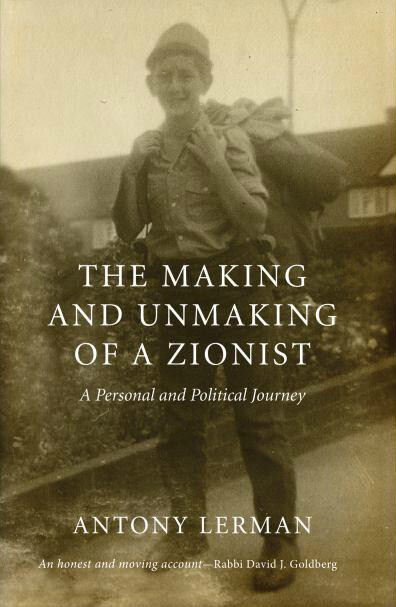The Electronic Intifada London 9 October 2012

These questions are addressed in The Making and Unmaking of a Zionist, a new memoir by Antony Lerman.
Born to moderate orthodox parents in Golders Green (3), London, Lerman joined the Habonim labor Zionist youth movement in his teens. Along with its youth centers, Habonim owned a remote East Sussex farm known as the hachshara (“training”) where it prepared members for life in the kibbutzim, Israel’s collective agricultural colonies (31).
He eventually went on to become leader of the movement in the UK. Although after 1967 Habonim activists still saw themselves “as guardians of moderate and liberal socialist Zionism … the vast majority of us slipped so easily into a way of thinking that legitimized the occupation” of the West Bank, Gaza and the Syrian Golan Heights (34-5).
“Gunning for Lerman”
After visits, he emigrated to Israel in 1970 before eventually joining a kibbutz (36-9), membership of which was the ultimate aspiration for all Habonim members. Soon after serving in the Israeli army, doubts about the dullness of the physical labor so central to kibbutz life got the better of him (50). He left in 1972. Lerman wanted to pursue a more academic way of life.
He went on to work at the forerunner of the Institute for Jewish Policy Research (JPR). His work there and for Yad Hanadiv, the grant-giving foundation of the influential Rothschild dynasty was focused on programs aiming at the renewal of Jewish life in Europe. By 1999, “I no longer regarded myself as a Zionist … [but] still had faith in the 1993 Oslo accords,” he writes (103). He returned to the JPR as director in 2006 (137).
But right from the start, there were many in Jewish establishment circles who were “gunning for Lerman” (the title of chapter 12). Almost as soon as the news of Lerman’s appointment broke, The Jewish Chronicle’s “influential weekly columnist, Geoffrey Alderman, in an article entitled ‘JPR loses mind in choice of new head,’ launched an attack on me.” Alderman attacked Lerman’s views on anti-Semitism, Israel and Zionism as beyond the pale (142).
Such opposition, and the withdrawal of funding took their toll, and Lerman offered his resignation in November 2008. The board almost seemed relieved: “It is probably for the best, but I am sorry that it has ended this way” (190). Staunch Lerman critic David Hirsh, a sociologist with Goldsmiths, a college in south-east London, and founder of Engage (a website opposing the boycott of Israel), sent a letter “already putting himself forward for the directorship” days later (191) (he failed).
Objectionable insights
Palestinians and other Arabs figure little in the early part of this book. Lerman is even honest enough to admit that in Habonim, he thought very much of Palestine “in classic Herzlian terms as ‘a land without a people for a people without a land’” (8), a reference to the reputed founder of Zionism, Theodor Herzl. “When I went to live on Kibbutz Amiad in the Galil [Galilee], I never bothered to wonder who lived on the land before the settlement was founded in 1946. For many years after, I remained completely oblivious to the fact that the population of the nearby Arab village of Jubb Yusuf had been forcibly driven out” (194).
A most interesting aspect of this political memoir, is how Lerman’s passion for Jewish cultural life in Europe made him highly critical of Zionism.
As he points out, there is a certain nexus between Zionism and anti-Semitism. Approvingly summarizing the thesis of academic Idith Zertal, he writes: “It was in Zionism’s interest that Jews outside Israel were discriminated against, as this legitimized claims that Zionism was the only long-term solution to the Jewish question … [these] arguments made it easier to understand why Israel used anti-Semitism for political purposes, a point I had been making for some years” (179).
One of the main themes in the book is the way Israel uses the threat of anti-Semitism to encourage Jews to move to Israel: “Especially troublesome [in the early 90s] was the Project for the Study of Anti-Semitism at Tel Aviv University … in short, the Israeli government’s civil arm devoted to monitoring and dealing with the problem of anti-Semitism, working hand-in-hand with [Israeli spy agency] the Mossad, was acting as a Zionist recruiting tool of the crudest kind” (99).
Such insights are why the Aldermans of this world found Lerman so objectionable and sought to depose him.
Lerman settles scores with establishment figures who have wronged him. He puts across his side of the story frankly. But this is never done in a bitter or petty fashion. In fact Lerman has been remarkably tolerant, considering some of the abuse he has had to put up with.
This is a brave and honest book. Lerman has been frank about opinions he once held, views he would now reject. While inevitably there is a focus on the nagging doubts he had even while still a committed Zionist, there is no attempt to whitewash his past opinions.
Asa Winstanley is an investigative journalist from London who has lived and worked in occupied Palestine.





